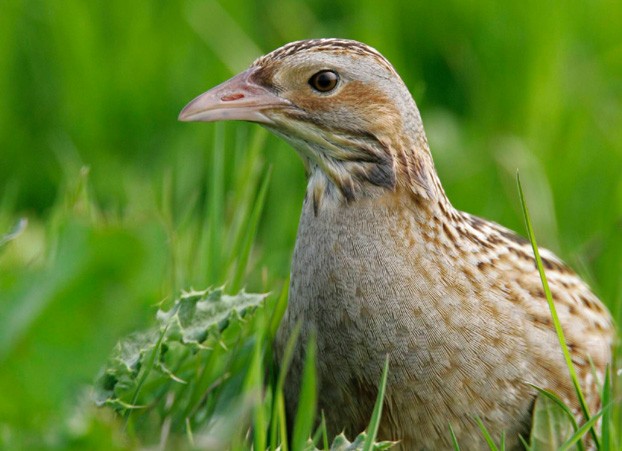Chapter Three of Mr Key’s Book Of Birds, a work in progress.
The corncrake is a type of bird. Its call is raucous and alarming. To gain an idea of how raucous, how alarming, imagine you are fast asleep in bed. Because you are obsessed with the rigours of polar exploration, you sleep, like Roald Amundsen, with your bedroom window wide open in all seasons of the year. Through this open window flies a corncrake, and it comes into land upon your head. Ordinarily, the sensation of its talons digging into your bouffant to steady its perching would awaken you. But you are wearing your thickly-woven woolly swaddling sleep helmet, as recommended by Von Straubenzee. Having suffered from debilitating insomnia for many years, you studied Von Straubenzee’s exciting new discipline of snoozetics. Now, before retiring, you drink a pint of lukewarm milk of magnesia, picture yourself tossing the contents of your brain into a wooden crate and hammering shut the lid of the crate with ten thousand nails, the same number of nails Cornelius Cardew thought sufficient to seal the coffin of imperialism, and you don the sleep helmet before hopping – never climbing, but hopping – into bed. You have found that ever since following Von Straubenzee’s procedures religiously, your sleep is deep and untroubled and not unlike a coma. Thus when the corncrake alights upon your head, and digs its talons into the thick wool of your sleep helmet to steady itself in its perching, you do not feel a thing. You remain fast asleep, content and snug in la-la land.
From its perch, the corncrake surveys its surroundings. If you asked it why it had flown in through the window, and if it was somehow capable of responding in an approximation of human speech so that you understood its reply, it is likely that the corncrake would have absolutely no idea what impelled it. Who knows why birds do what they do? Not even the birds themselves know, for their brains are tiny. Rather than using reason, birds follow the dictates of instinct, what you or I would call “gut feelings”. All we are able to say is that, on this occasion, the corncrake saw the open window and took the opportunity to fly into your bedroom, probably in the hope of finding something to eat. Fortunately, densely-woven wool does not feature as part of a corncrake’s regular diet.
So while the bird rests from the exertions of its flight, perched on your head, it trains its two black fathomless savage inhuman eyes upon your bedroom. It takes in the frieze of martyred saints above the dado rail, the wainscot, the wardrobe, the chest of drawers, the rug and the unseemly stains. It takes in the clutter atop the bedside cabinet, the glass of water, the folded spectacles, the scrunched tissue, the anglepoise lamp, the stray button, the biro, the pins, the bowl, the dust, the cardboard carton of pills, the alarm clock, the other button, the little jars, the littler bottles, the nameless thingummy, the biscuit crumbs, the snuffbox, the coinage, the pipe-cleaners, the mud idol, the cotton wool, the toffee apple wrapper, the handkerchief, the string, the puppet, the putty, the duster, the rag, the bus ticket, the scrap of paper, the pocket Bible, the rosary beads, the taffy tin, the bonbon, the monkey snapshot in its frame, the atomiser, the shopping list, the rubber band, the drawing pin, the plaster Madonna and Child statuette, the sophisticated cocktail party invitation, the chewing gum, the gloves, the telephone. Were it a magpie or a jackdaw, rather than a corncrake, it might swoop and snatch up in its beak one of the smaller items on the top of the cabinet and fly out through the window and away, to deposit the stolen gewgaw in its nest. In folk tales and legends, magpies and jackdaws often appear as thieves, the bird equivalents of opportunistic pickpockets, and this characterisation has some basis in brute avian fact. Not so the corncrake, which is not thought of as a pillaging bird. So while it gazes upon the clutter, it remains still, perched upon your sleeping head, and swoops not to snatch booty in its beak.
Stille Nacht. It would be hard to imagine a night more still, more silent than this one. The Von Straubenzee method ensures you make no stentorian snoring noise. The sound of your breathing is almost imperceptible, muffled by the sleep helmet. The corncrake’s breathing is equally quiet. Nothing stirs in your bedroom, and from outside, through the open window, there is not even a breath of wind. It is as if the planet has fallen asleep with you.
I have said that we can have no idea what prompts a bird to do what it does. So I can offer no logical, reasoned explanation for the sudden loud jarring raucous cry of the corncrake on your head. It makes its harsh caw twice, then lifts off, and flies away out of the window. The effect on you is instantaneous and awful. You waken, alarmed, indeed panic-stricken, as if prodded with a burning hot pointy stick. You do not see the corncrake fly away, so you cannot account for the horror by which you are convulsed. Trembling, you clamber out of bed and shuffle to your toilet to piddle, a piddle occasioned by fear. Such is the raucous and alarming call of the corncrake.


Hark! Concrete!